It was with great curiosity that Janmajeya requested the learned saint Vaisampayana to narrate the story of his ancestors, the Pandavas. What followed next, changed Janmajeya’s entire perspective towards life. He had just become the first person in history to listen to the narration of the Mahabharata; a story so violent yet exceedingly calm, so bizarre yet believable, so powerful yet incredibly sublime.
The Mahabharata is one of the most sacred Hindu texts ever to be written. The composition of the epic includes over a hundred thousand slokas or two hundred thousand individual verse lines containing a rough estimate of about 1.8 million words.
The largest epic poem ever written, the Mahabharata is roughly ten times the length of the Iliad and the Odyssey combined. The book is divided into eighteen parvas with each Parva covering a significant period within the Mahabharata. It is believed that the scholarly sage Ved Vyasa dictated the entire chronicle in a single breath, while the elephant-headed god Ganesha wrote it down at an unbelievable pace.
Historians have spent many sleepless nights speculating the period in which the epic saga took place. Although there is no conclusive evidence to support this claim, many scholars believe that the Mahabharata took place somewhere between 1500 and 1000 BCE.
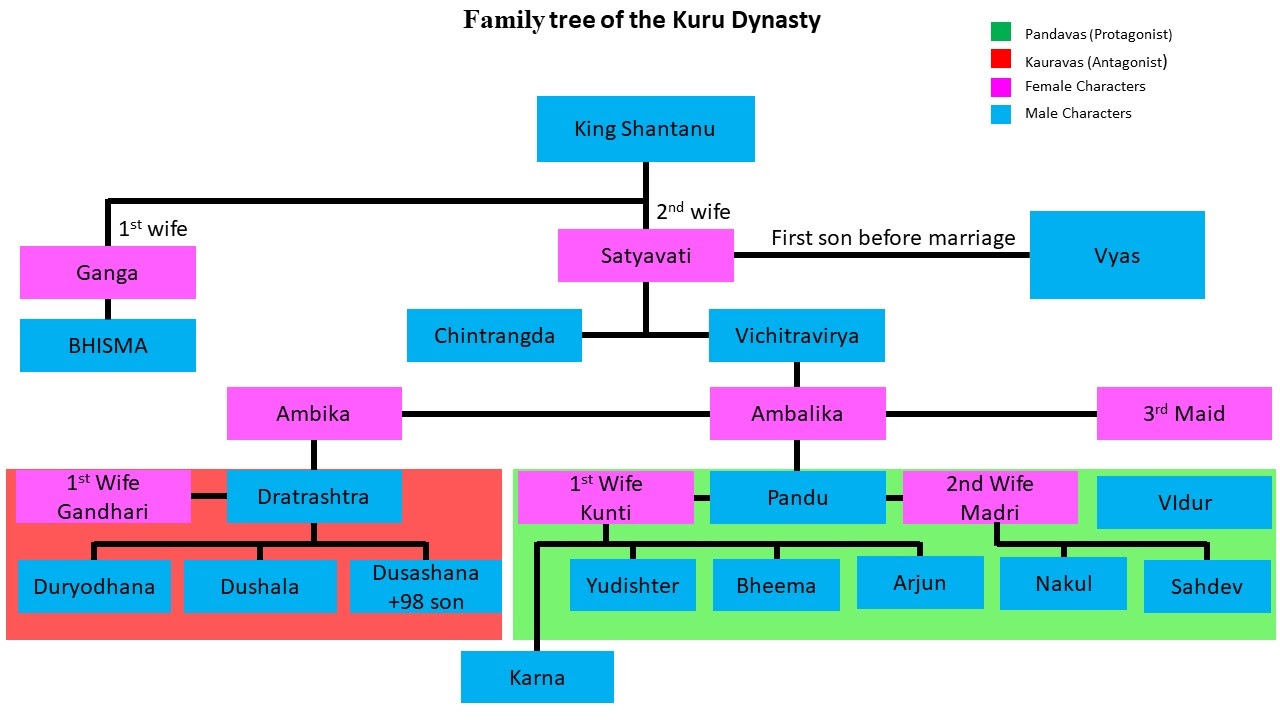
(Public Domain)
The Beginning
The story of the Mahabharata began centuries before Janmajeya ascended the throne, at the banks of the river Ganga. The then ruler of Hastinapura, King Shantanu has just discovered a beautiful woman idly strolling across the banks of the mighty river. Smitten by her beauty, Shantanu requested the woman’s hand in marriage, oblivious to the fact that she was the personification of the river Ganga.
As the couple joined in matrimony, Ganga asked her husband to keep a promise. She demanded that regardless of the nature of her actions, Shantanu would never question nor stop her. The love-struck Shantanu was quick to agree, unable to notice the secretive nature of the promise.
Gangaputra Devavrata
Soon enough, the couple was blessed with a child but to Shantanu’s horror, Ganga drowned the child in her own waters. Honoring his promise, Shantanu did not interfere as Ganga proceeded to drown seven of their children. By the birth of their eighth child, the father within Shantanu could not bear the thought of losing another son. Determined to save his heir, Shantanu confronted Ganga and stopped her from drowning their child. It was at this moment that Ganga chose to reveal the true purpose behind her drowning the children.
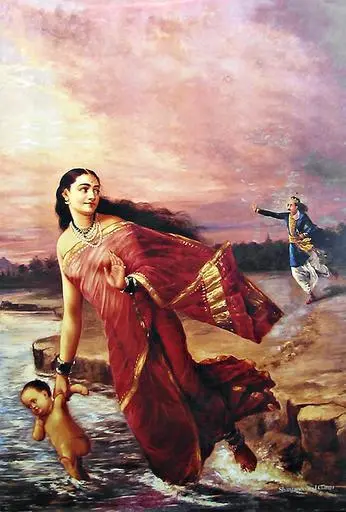
(Public Domain)
The children were but the incarnations of the Eight Vasus, who had been cursed by the sage Vashishta in their previous birth. They were doomed to be reborn as mortal men, and endure a lifetime of suffering. The only way to lift the curse was to limit their mortal life to less than a year. Ganga had successfully lifted the curse off seven of the Vasus but was unable to do the same for the eighth one. She named the baby Devavrata and revealed to the astonished King her intention of taking the boy to the heavens and training him to become a virtuous and powerful warrior.
Deavratta’s birth marked the beginning of a vital phase in the Mahabharata. After years of training, Devavrata returned to his father as a young and eager man, ready to take up the mantle of the King of Hastinapura. Alas, the prince was oblivious to the fact that he had been doomed to a life of suffering.
Satyavati: The Fisherman’s Ambitious Daughter Turned Queen
Devavrata’s life started going downhill, the second his father met Satyavati at the banks of the Yamuna. Satyavati was the daughter of the chief fisherman of the village and her beauty was a sight to behold. The King of Hastinapura fell madly in love with Satyavati only to be denied permission to marry her by her father.
Her father was afraid that the children of a fisherwoman would never be accepted in the palace. He believed that once Devavrata assumed the title of King, Satyavati, and her children would be thrown out of the palace due to their lower caste. Therefore, the chief fisherman gave the king an ultimatum. He would agree to let her daughter marry Shantanu only if Devavrata renounced the title of Crown Prince. The heartbroken Shantanu was unable to accept the fisherman’s condition as he could not deny Devavrata his rightful position. Dejected, he returned to Hastinapura.
The Terrible Oath of Bhishma
The young Devavrata sensed something wrong with his father. After investigating, he found out about Satyavati and headed out to confront her. Upon his arrival, the fisherman made the same arguments for the young prince. To his extreme surprise, the son of Ganga did not flinch as he gave up his position as the crown prince of Hastinapura. The fisherman, although shocked, was not satisfied. He stated that although he trusted Devavrata to keep his word, he was afraid, the Prince’s children would overthrow the children born to Shantanu and Satyavati.
This argument made by Satyavati’s father is one of the most significant moments in the epic. After carefully listening to the fisherman’s plight Devavrata took an oath so terrible that celestials from the heavens showered him with flowers. Devavrata vowed that he would lead a life of celibacy and serve whoever assumed his father’s throne. Such was the nature of his oath, that from that day onwards, he was called Bhisma, the one who took the terrible oath. Taken aback by his son’s devotion to him, Shantanu blessed Bhishma with “Iccha Mrityu” – the control over death, thereby making Bhishma immortal.
Bhishma’s Loyalty To Throne
Shantanu’s marriage to Satyavati resulted in the birth of two sons: Chitrangada and Vichitravirya. After Shantanu’s demise, Chitrangada ascended the throne of Hastinapura. The young king was renowned as a fierce warrior and an able ruler, vanquishing many of his enemies in battle. The king’s victory streak, however, came to an end, when he crossed paths with the king of the Gandharvas, who shared his name. The battle between both the Chitrangada’s was legendary and lasted for 3 years until finally, the Gandharva King emerged victoriously. Chitrangada perished in battle and the responsibility of the kingdom fell onto the shoulders of the young prince Vichitravirya.
Unlike his older brother, Vichitravirya had been pampered throughout his life and did not have the qualities that great kings before him had possessed. Nevertheless, under Bhishma’s supervision, Vichitravirya was proclaimed the king of Hastinapura.
As the immature King approached manhood, Bhishma took on the responsibility of finding a suitable bride for his half-brother. His search took him to the kingdom of Kasi, where, on behalf of his brother, he competed for the princesses’ hands in marriage. Bhishma emerged victorious in the swayamvar and brought home the three princesses for his half-brother.
The eldest princess Amba, however, was secretly in love with Prince Shalva, the ruler of Saubala. Upon her arrival in Hastinapura, Amba begged Vichitravirya to let her go and marry Shalva instead. The king who was already happy with his two new wives gave Amba permission to go to Saubala. Amba’s happiness was short-lived as Shalva rejected her. With a broken heart, she returned to Hastinapura and begged Bhishma to marry her. The great warrior had to refuse, leaving Amba stranded with no place to go.
Amba’s Revenge
Fueled by her anger and resentment towards Bhishma, Amba approached Parshurama, the warrior sage who was also the guru (Sanskrit: preceptor) of Bhishma itself. Parshurama catered to Amba’s request and challenged Bhishma to a duel. Bhishma and Parshurama fought for 23 days but both the opponents were equally matched. Much to Amba’s disappointment, Bhishma continued to live.
The fierce princess did not lose hope though. Eager to get her revenge, she prayed to almighty Shiva. When Shiva finally appeared in front of her, she asked him for the strength to kill Bhishma. Shiva granted the wish and stated that she would only be able to do so in her next birth. Without thinking twice, Amba jumped into a fire and gave her life.
Vichitravirya’s Demise
Back in Hastinapura, Vichitravirya was madly in love with both his beautiful wives, who adored him equally. With Bhishma handling the affairs of the kingdom, the youngest son of Shantanu spent most of his time drinking in the company of his wives. After seven years of marriage, Vichitravirya’s alcohol consumption caused him to fall severely ill. Despite the efforts of the most learned physicians, Vichitravirya died a painful death, without conceiving an heir for the throne.
The Birth of Pandu and Dhritarashtra
The untimely death of Vichitravirya was a source of great concern for Queen Mother Satyavati. The death of Vicitravirya meant that there was no heir to the throne. Having no choice left, Satyavati called upon a person, who she had avoided for the majority of her life. This person was her bastard son Dvaipayana, who later became the sage Veda Vyasa, the author of the Mahabharata.
After years of separation, Satyavati finally decided to call Vyasa for help and proceed with Niyoga. The rules of Niyoga dictated that in the event of a King’s demise, a rishi could be called upon to impregnate the queens.
Vyasa’s years in the forest had made him hideous to look at, therefore when he went into Ambika’s chambers to spend the night with her, the queen, terrified of his appearance, kept her eyes closed for the entire duration of his stay. Consequently, the son born to Ambika was blind. Her blind son was named Dhritarashtra, who grew up to be the father of the Kauravas.
Satyavati was disappointed with the birth of a blind grandson. She asked Vyasa to impregnate the younger Queen Ambalika, in the hope of better results. As Ambalika saw Vyasa, she became pale with fear, causing her to give birth to a pale and extremely light-skinned child. This baby was named Pandu, who grew up to be the father of the Pandavas.
Satyavati was not satisfied with either Dhritarashtra or Pandu. She wanted her grandson and the next King of Hastinapura to be perfect. She commanded Ambika to spend another night with Vyasa and conceive one more child. The queen, terrified at the prospect of facing Vyasa again, appointed a handmaiden to go in her stead. The handmaiden Parishrami faced the sage without any fear. The son born of their union was named Vidura, who grew up to be the prime minister of Hastinapura.
Pandu’s Accession to the Throne
Growing up, the three brothers were inseparable. Although blind, Dhritarashtra had been blessed by Vyasa to wield the strength of a hundred thousand elephants. Pandu on the other hand had mastered the use of weapons and was skilled in warfare. Unlike his older brothers, who were born of royal blood, Vidura spent most of his time studying and understanding the affairs of the state.
Soon the brothers reached manhood and under the supervision of their great-uncle, Bhishma, all three of them had proven themselves worthy of the title of King. Vidura’s low birth meant he could not assume the throne and the main candidates became Dhritarashtra and Pandu.
Due to Dhritarashtara’s blindness, Pandu was declared king. Dhritarashtra was disappointed but willingly conceded the crown, though this act would flower into the protectiveness he would have over the crown later in his life.
The Marriage of the Kuru Princes
As both princes reached manhood, Bhishma took up the responsibility of getting them married. As Dhritarashtra was the old brother, Bhishma decided to arrange his marriage first. He headed to the kingdom of Gandhar, where he came across princess Gandhari. The young princess was taken to Hastinapura and was married off to Dhritarashtra. As a symbol of love and devotion towards her husband, she blindfolded herself to better understand his struggle. This decision by Gandhari greatly troubled her brother, Shakuni, who made it a point to teach the Kuru clan a lesson.
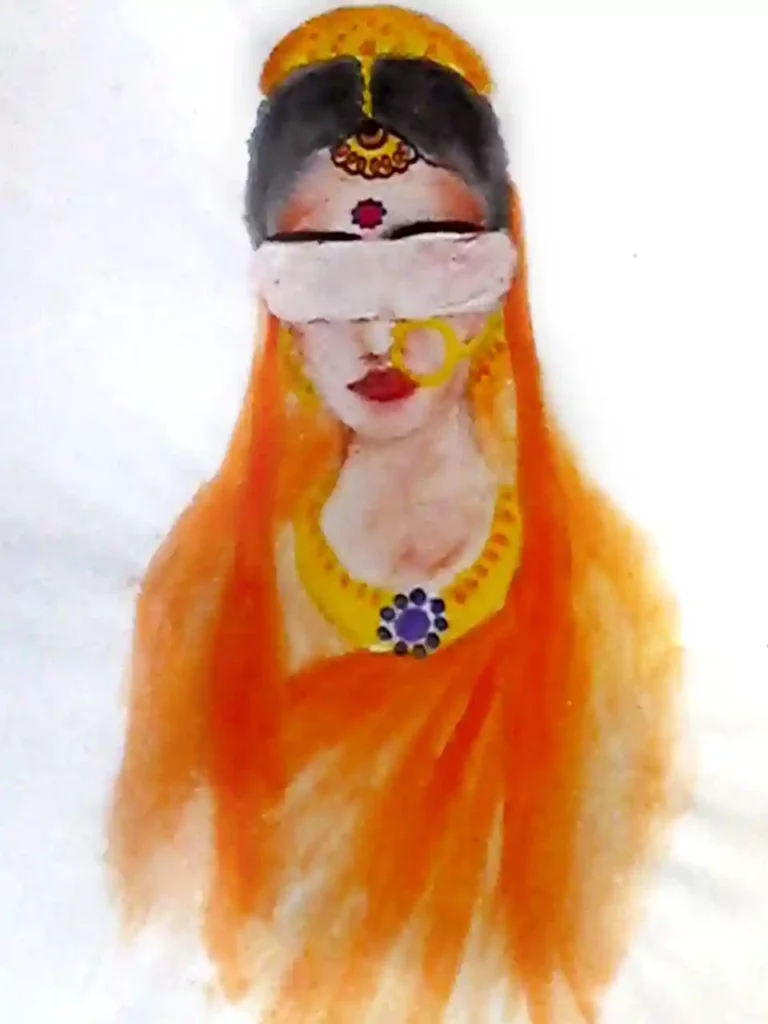
(Public Domain)
Soon after Dhritarashtara’s marriage, Pandu was married to princess Kunti, the adoptive daughter of King Shurasena, the king of Kuntibhoja. Soon after that, during a conquest in the Kingdom of Madra, Pandu met Madri, the sister of King Shalya, the king of Madra. As a token of friendship, Shalya offered Pandu, Madri’s hand in marriage, and the King of Hastinapura was married again.
Pandu’s Curse
On one eventful day, while hunting in the forest, Pandu came across two deer, in the process of making love. For the king of Hastinapura, the two clueless deer were easy targets. With a single arrow, Pandu managed to hit both of them. It was only after the arrow struck them that Pandu realized that the deer was the Rishi Kindama and his wife, making love in the form of animals. Rishi Kindama was enraged and in his dying condition cursed Pandu. As Pandu had killed him and his wife, while they were engaged in coitus, the sage cursed Pandu stating that if he ever approached his wives intending to make love, he would die on the spot.
Dhritarashtra: The De Facto King
The nature of the curse was so devastating that Pandu decided to give up the throne and head out into the forests along with both his wives. His actions ashamed him and he decided to lead a life asceticism, devoid of any form of pleasure. In his absence, Dhritarashtra assumed the throne of Hastinapura as the de facto King.
The Pandavas and The Kauravas
Even in the forest, Pandu was deeply troubled by the fact that he would not be able to father any children. Seeing her husband in such agony, Kunti decided to share a secret with Pandu.
Many years ago, the pious sage Durvasa had rested at Kuntibhoja. During his stay, the young princess Kunti had catered to his every need, ensuring that he was never uncomfortable for even a brief moment. The rishi was extremely pleased with her service and granted her a boon with which she could invoke any god and be blessed with that devata’s (Sanskrit: God) child.
Interestingly, Kunti had used this mantra before marrying Pandu, to invoke the Surya Dev (The Sun God). The young Kunti realizing the rash decision she had made, placed the infant in a basket, and set it adrift in a small river by the palace. The infant was adopted by a charioteer and his wife in Hastinapur and was named Karna. Over the years, Karna would grow up to become a fierce warrior and a close ally of the Kauravas.
The Birth of the Pandavas
When Kunti informed Pandu about this mantra and said the former king was overjoyed. The first god invoked by the couple was Dharmaraja, the god of Dharma. The devata blessed them with Yudhishtira, the first son of Pandu. Kunti went on to invoke Vayu and Indra and was blessed with Bhima and Arjuna respectively.
While Pandu was extremely pleased with the birth of three sons, Madri was deeply jealous. She approached Kunti and begged her to share the mantra with her. She was afraid that Pandu would stop loving her as only Kunti had provided him with children. Kunti, who was known for her generosity, shared the secret mantra with Madri. The younger wife invoked the Ashwini twins and was blessed with twin babies Nakula and Sahadeva.
The Birth of the Kauravas
While Pandu was away in the forest, back in Hastinapura, even Dhritarashtra and Gandhari were having trouble giving birth. When news regarding the birth of Pandu’s first child reached Hastinapura, Dhritarashtra was furious. He lashed out at Gandhari and proclaimed that her boon for a hundred sons was false. The fact that Kunti had given birth before her, was deeply frustrating for her. She struck her stomach repeatedly in anger until she started experiencing labor. Her excitement was soon converted into sorrow as instead of a child, she gave birth to a mass of flesh.
The sage Veda Vyasa was summoned to Hastinapura to make sense of Gandhari’s delivery. The learned sage proceeded with a ceremony, wherein he cut the mass of flesh into a hundred and one parts. The tiny pieces of the flesh were placed in a pot and sprinkled with water. Within a matter of two years, the pounds of flesh developed into one hundred sons and one daughter. The eldest son of Gandhari and Dhritarashtra was named Duryodhana.
Pandu’s Demise
A few years after the birth of the Pandavas, Pandu found himself smitten with Madri’s beauty. Unable to resist himself, Pandu approached his wife intending to make love. He had, however, forgotten the Rishi Kindama’s curse, and met his end as he embraced Madri. The younger wife, blaming herself for her husband’s death, jumped into his burning pyre leaving Kunti with the five Pandavas.
The Pandavas’ Arrival at Hastinapura
After Pandu’s demise, Bhishma brought back Kunti and the Pandavas to their rightful home in Hastinapura, where King Dhritarashtra welcomed his sister-in-law with open arms. The young Pandavas on the other hand received no hospitality from their cousins the Kauravas. Duryodhana saw Yudhishtira as a constant threat to the throne and thus began the rivalry that defined the Mahabharata.
Education And Training
As the 105 princes were getting older, Bhishma decided that it was time they received proper training in weaponry and governance. The great-uncle of the princes sent them to the ashram of the pious sage and warrior Dronacharya.
Under Dronacharya’s tutelage, the princes of Hastinapura studied all forms of war and sciences. Among all his pupils, Dronacharya’s affection towards Arjuna was evident. Drona promised Arjuna that the latter would become the successful warrior in the world.
Duryodhana’s hostility turned into murderous hatred
The princes returned to Hastinapur as young men, capable of fighting and defending their kingdom. It was upon Dhritarashtra to proclaim the next heir apparent of the Kingdom. After plenty of debate and discussion, Dhritarashtra, under the pressure of his ministers, declared Yudhishtira as the crown prince of Hastinapura. The fact that his father had chosen Yudhishtira as the future king infuriated Duryodhana beyond measure. Duryodhana’s jealousy of Yudhishtira got converted into extreme hatred towards the Pandavas. He had decided that under no circumstances could he let Yudhishtira become the king.
Lakshagriha: The House of Wax
Duryodhana’s hatred towards his cousins led him to take drastic measures to get rid of them. Under his uncle Shakuni’s influence, Duryodhana devised a plan to end the Pandavas once and for all.
Duryodhana hired a skilled architect, named Purochana, to construct a house of wax in a forest near the city of Varnavat. He arranged for the Pandavas and their mother to go there and enjoy a local festival. On their arrival, the Pandavas realized that the house was made of wax and was meant to burn them alive. With the help of Vidura, they escaped the Lakshagriha and started living in secrecy. Before their departure, the Pandavas invited an old Nishada woman and her five sons into their palace. The fire that was meant to kill them, burned the Nishada family instead and it was their bodies that convinced Purochana that the Pandavas had truly perished. Back in Hastinapura, as the palace mourned for the Pandavas, Duryodhana was proclaimed heir apparent.
Arjuna and Draupadi
Meanwhile, the Pandavas and Kunti went into hiding, the Pandavas lived as ascetics and traveled around the country. One day, news regarding the swayamvar of the beautiful princess of Panchal, Draupadi, reached Arjuna’s ears. Eager to witness the swayamvar, the Pandavas traveled to Panchal.
The challenge within Draupadi’s ceremony required the participant to look into a bowl of water and shoot the eye of a moving fish placed on the ceiling. Countless kings and princes failed to hit the target and the king of Panchal, Drupad, decided to open the ceremony for commoners.
Arjuna in the form of a Brahmin approached the dais and shot the target with ease. Duryodhana who was present at the ceremony was appalled at the prospect of a Brahmin being better than him. Along with the other princes, he attacked Arjuna. The rest of the Pandavas joined the battle and successfully took Draupadi home with them.
Pleased with his victory, Arjuna rushed home to tell his mother about his new wife. He asked Kunti to guess what he just won. The solemn Kunti, oblivious to the circumstances, thought Arjuna had collected food and instructed him to share it with all his brothers. The obedient Pandavas, although hesitant, decided to share Draupadi, and the princess got married to all five brothers.
The Partition of Hastinapura
With their cover blown, the Pandavas returned to Hastinapura with their wife. Yudhishtira’s return once again ignited the debate concerning the throne of Hastinapura. Dhritarashtra realized that his adamant son would never give up the throne and decided that the only way to solve this issue would be by dividing the kingdom in half.
The Kauravas got Hastinapura and the Pandavas were left with the inhospitable city of Khandavprastha. Although it was not a fair deal, the Pandavas graciously accepted the desolate city and in a matter of years, turned it into the greatest city in the country.
Indraprastha
Yudhishtira’s success was a cause of great jealousy for Duryodhana. After completing the Ashwamedha Yagna and becoming the Chakravartin Samrat, Yudhishtira invited various kings to visit his palace.
Duryodhana was also invited to the ceremony and arrived at the palace in distaste. The ceremony however was not peaceful. After a scuffle broke out between the cousins, the weapons of the Kauravas were confiscated. Furious at the insult, Duryodhana stormed out of the palace. On his way out, Duryodhana accidentally fell into a small pool. There was awkward laughter around the chambers and Duryodhana heard Draupadi saying that a blind man’s son is always blind. This was more than Duryodhana could take. He was livid at Draupadi’s remark and decided to take revenge on the Pandavas.
The Dice Game: Fall of Pandavas
Shakuni and Duryodhana jotted down a well thought out plan to defeat the Pandavas. They invited Yudhishtira to a game of dice in Hastinapura knowing very well that it was his only weakness. The game of dice started well and Shakuni let Yudhishtira win a few rounds to boost his confidence. But soon the game turned around.
In a matter of minutes, Yudhishtira gambled away all his wealth, his kingdom, and having no choice left, started betting his brothers. Yudhishtira was no match for Shakuni’s skills and soon all five Pandavas were slaves of the Kauravas. In a final attempt to win back everything, Yudhishtira bet his wife Draupadi and naturally lost again.
For the euphoric Duryodhana, this was the moment he was waiting for. He instructed his brother Dushasana to go to Draupadi’s chambers and drag her to the court by her hair.
Draupadi kicked and resisted as she was dragged by the hair. To end Draupadi’s pride once and for all, Duryodhana commanded Dushasana to disrobe her in front of the entire courtroom. The helpless Pandavas watched in shame as Dushasana started pulling Draupadi’s saree apart.
In what can be considered the most divine moment in the Mahabharata, the saree being ripped off of Draupadi seemed to go on endlessly. The exhausted Dushasana kept pulling, but to no avail. It was the celestial Krishna, whose blessing helped Draupadi keep her dignity.
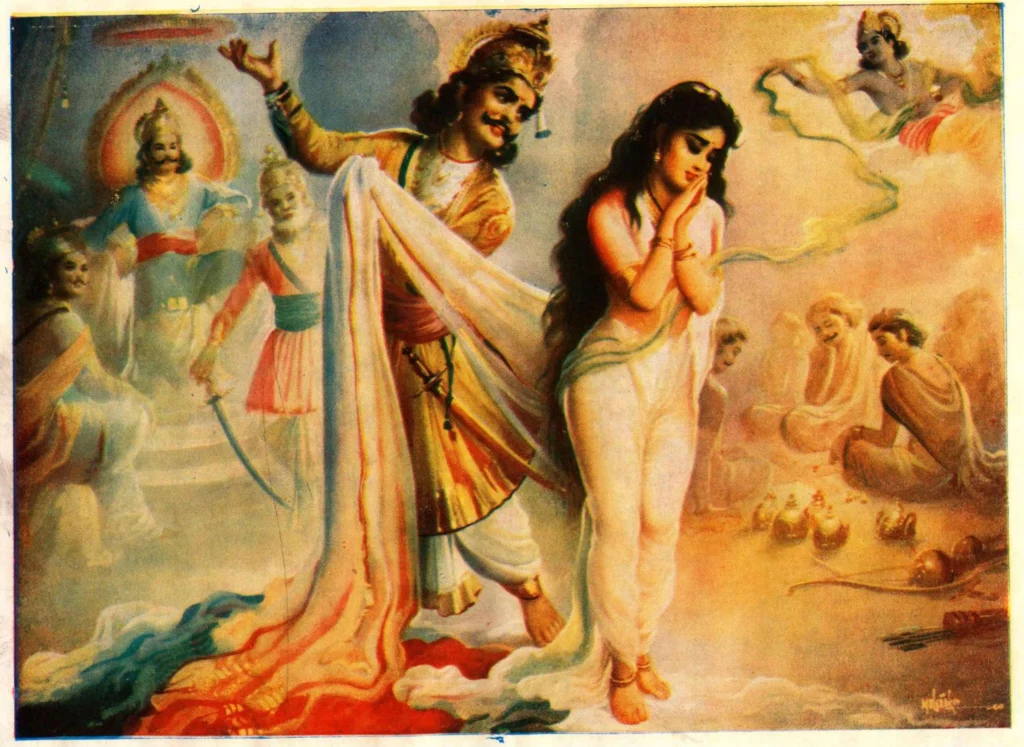
(Public Domain)
Finally, Dushasana stopped. The entire courtroom was too shocked and embarrassed to look at Draupadi. The wife of the Pandavas called out all the men in the assembly for their cowardice. She went on to add that she would not tie her hair again until it was washed with Dushasana’s blood.
The embarrassed Dhritarashtara asked the Pandavas and Draupadi to forgive them and return to Indraprastha. But after arguments from Duryodhana and Shakuni pointing out that they had lost fair and square, a new set of arrangements were made.
The Pandavas would be exiled for 12 years, during which they would live in the forest as ascetics. After the completion of these 12 years, they would lead one year in Agyatvas i.e. in hiding. If during this one year, the Kauravas found out the Pandavas, they would have to repeat their sentence.
With those terms, the Pandavas along with Draupadi went into the forest.
The Exile
It was evident to the Pandavas that even if they completed the terms of the exile, the Kauravas would never willingly give them their kingdom. Therefore, during this period, the Pandavas made alliances with various kingdoms, hoping they would support them during the inevitable battle.
After 12 years of exile, the Pandavas went incognito for one year. They hid in the kingdom of Matsya and assumed various roles within the King’s palace. Yudhishtira became a counselor to the king, Bhima worked in the royal kitchens, Arjuna turned himself into a eunuch and taught music and dance to the princess, the twins worked in the stables and Draupadi became a handmaiden to the queen.
Although the Agyatvas period of the Pandavas was not entirely peaceful, they managed to get through it, until the very last day. As their Agyatvas came to an end, the Kaurava army attacked the Kingdom of Matsya. Prince Uttara, son of King Virat was sent to battle them with Arjuna as his charioteer. The young prince was terrified and about to retreat when Arjuna revealed his true identity and fought off the army.
Although the period of Agyatvas was over, the Kauravas refused to return Indraprastha to the Pandavas. After 13 years of exile, the Pandavas knew that it was finally time to end this feud once and for all.
The Great Kurukshetra War
After their exile was over, the Pandavas sent Krishna to Hastinapura, hoping to negotiate their return peacefully. Despite their best efforts, the Kauravas declined their requests and the great war between the cousins was fought. As Arjuna arrived at the battlefield, with Krishna as his charioteer, he saw familiar faces of friends and family all around. Arjuna expressed doubts regarding the war to Krishna, stating his duty towards family. Krishna then assumed his true form as the Paramatma and explained to Arjuna, the importance of fulfilling one’s duty. This long narration by Krishna right before the war is called the Bhagavad Gita. Enlightened by Krishna’s knowledge, the Pandavas and the Kauravas began the battle.
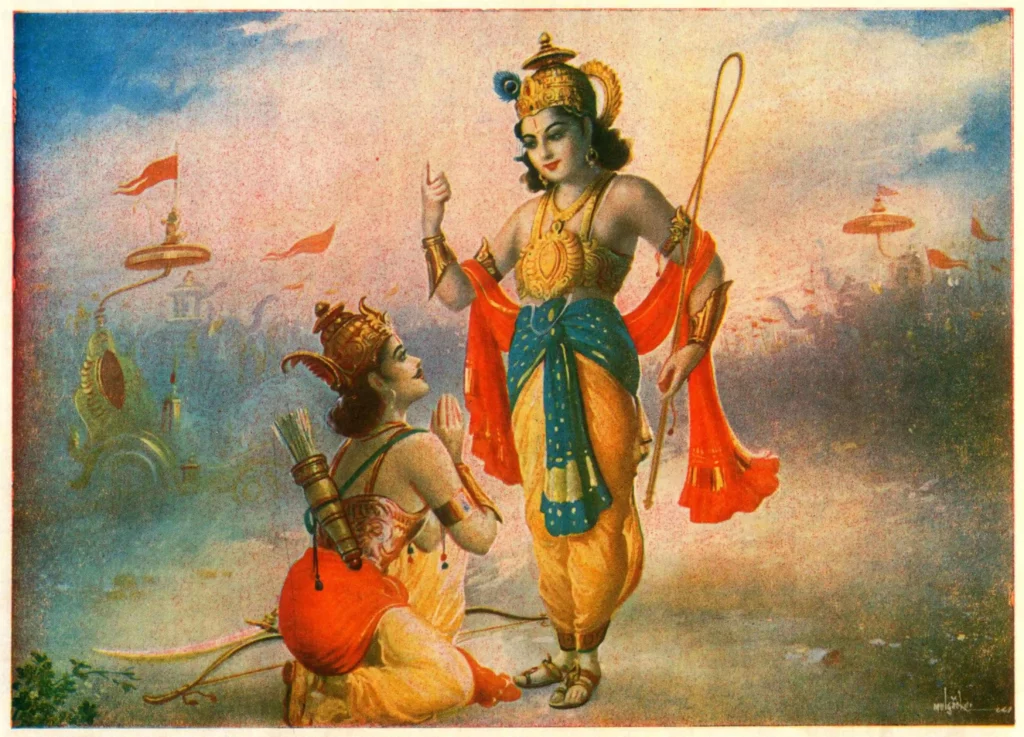
(Public Domain)
Never before had a war of such magnanimous proportions been fought. The warriors battled from sunrise to sunset for 18 consecutive days. The army totalled 18 Akshauhinis, 7 on the Pandava side and 11 on the Kaurava (1 akshauhini = 21,870 chariots + 21,870 elephants + 65,610 horses + 109,350 soldiers on foot). During the battle, most of the characters from the Mahabharata perished.
Amba, who had been reborn as Shikhandni, guarded Arjuna, as he shot Bhishma with a volley of arrows and left the old warrior lying on the ground with a bed of arrows. Bhima killed all the hundred Kauravas and helped Draupadi bathe in the blood of Dushasana.
Karna and Arjuna ensued in a vicious battle, where Arjuna emerged victorious as Karna suffered the consequences of a curse he had received decades ago, later it was revealed to Pandavas he was Kunti’s firstborn from before her marriage to Pandu, and thus, the eldest Pandava and the rightful heir to the throne.
After 18 grueling days, the war was over. Almost everybody the Pandavas knew and loved including all their children had perished, only Satyaki, Kripa, Ashwatthama, Kritavarma, Yuyutsu, and Krishna survived. It was a war not seen on a scale before or after, it was the Great Indian war, the Mahabharat.
Post-War Rule and Demise of the Pandavas
The distraught Pandavas returned to Hastinapura to face the heartbroken Dhritarashtra. Upon their arrival, Dhritarashtra along with Gandhari and Kunti left for the forests to spend the rest of their days in devotion to god.
Yudhishtira was proclaimed King of Hastinapura and the Pandavas spent their ruling days wondering whether the victory in the war was worth the loss they had suffered.
Yudhishtira and the Pandavas ruled Hastinapur for thirty-six glorious years. After handing down the crown to Arjuna’s grandson Parikshit, the Pandavas along with Draupadi left for the Himalayas intending to reach heaven by foot. On their journey, everyone except Yudhishtira perished. Finally, the eldest Pandava reached the gates of heaven, and on the other side met all his loved ones, including the Kauravas, living together in harmony.
The Legacy of the Mahabharata
On the surface, the Mahabharata is a tale depicting the great war between the Pandavas and the Kauravas carved by the fine threads of dharma and Adharma, greed and generosity, loyalty and betrayal, but at its very core, The Mahabharata is the complete truth of life.
The legacy of the Hindu epic has crossed Indian borders with the story making a significant impact in countries such as Indonesia and Malaysia. Bharatayuddha, as it is known in Javanese tradition, talks about the great battle that took place between the descendants of Bharata in the Dieng Plateau, Central Java.
Over the years, the popularity of the Mahabharata has risen dramatically. The epic has been adapted into various television shows and movies. The poem has been translated into multiple languages and authors around the world have reimagined the story in different and unique ways.
After his father, King Parikshit’s demise, Janmajeya made it his life’s mission to spread the tales of his valiant ancestors across the country. One can only assume he was successful as even after 3000 years, the legendary battle at Kurukshetra is etched into our hearts.


